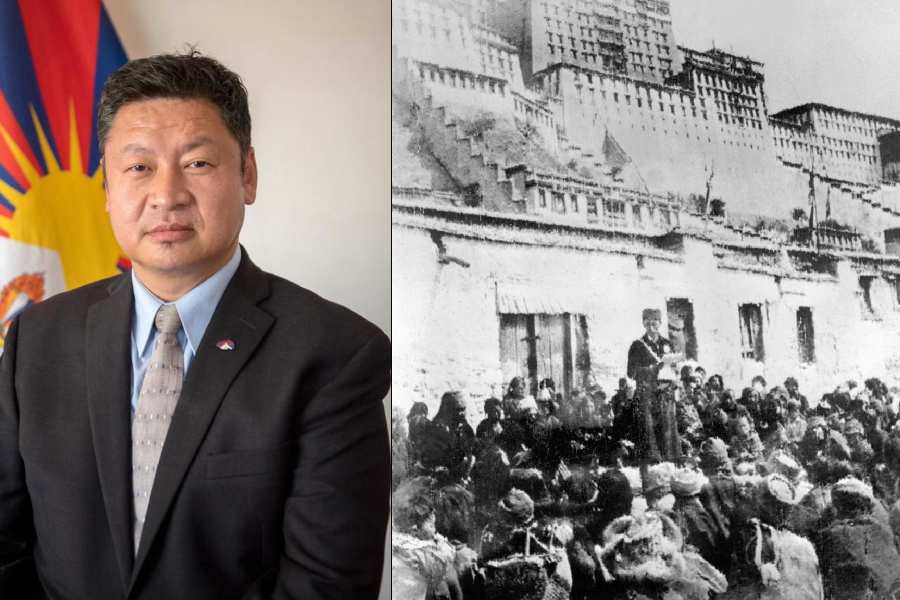Q What is the idea of home for the exiled Tibetan community?
Tibetans in exile are living in different homes away from home. Though many Tibetans in exile have not seen or lived in Tibet, we still believe that Tibet is our home where our heart belongs.
Q Usually, a duality complicates the emigrant experience of home. There is the original home and the home — in this case, India — that the new generation is born into. How do young Tibetans confront this dichotomy?
Like any other refugee community, we faced many challenges. Due to the visionary leadership of His Holiness the Dalai Lama and the older generations, and with the continued support of and assistance from the Indian government and the people, we have been able to build a home away from home where we remain as the voice for the voiceless Tibetans in Tibet.
Q Do Tibet’s spiritual/textual traditions assist in easing the anxiety of rootlessness?
Certainly. Tibetan Buddhist culture helps us cope with statelessness as it teaches the nature of interdependency and impermanence. It also instils hope not just within yourself but in your counterpart as well through compassion and positive changes.
Q Being homeless can also be a liberating experience since it widens horizons and dissolves borders. His Holiness, for instance, is a truly global citizen. How does the exiled Tibetan community view the tension and the ties between the Home and the World?
We can call it a blessing in disguise as it allows us to explore and understand the world and contribute to world peace. However, Tibetans inside Tibet are living a life in hell under the Chinese communist regime. Tibetan culture has been assimilated and Tibet economically marginalised and ecologically destroyed. Yet, the Sino-Tibet conflict remains unresolved. It is high time the Chinese leadership resolves this longstanding conflict through dialogue.
Q His Holiness has often spoken of changing the way of seeing or of looking at a problem from multiple dimensions to resolve conflict. Is multiplicity then the key to world peace?
Under the benevolent leadership of His Holiness the Dalai Lama, Tibetans at large, particularly the Central Tibetan Administration, are consistently pursuing the Middle Way Policy to resolve the longstanding Sino-Tibet conflict through meaningful dialogue, whereby both Tibetans and the Chinese will be mutually benefitted. The whole concept of the Middle Way Policy is based on trust, friendship and reconciliation for the sake of the entire humanity.
Q Not just politics, religion too seems to be narrowing given its insistence on homogeneity — Hindutva in India, militant Islam in Africa and Asia or aggressive Buddhism in Sri Lanka are examples. Why is this happening?
It is crucial to recognise that diversity is a reality and consider the different histories, cultures, geographies, livelihoods and faiths, among other factors. Therefore, insisting on homogeneity contradicts the essence of being human. China’s efforts to homogenise all nationalities in China are destined to fail.
Q Another major crisis for all our homes is climate change. Why is the global leadership not doing enough? How can Buddhism help?
Climate change is the real thing that everybody is facing. It is a universal challenge. Global leadership may amplify the need for sustainable development and ecology, but very little is being done on the ground. Look at China, the frontrunner for the global environmental leadership. Every year, about two million people die of air pollution. Eighty one per cent of China’s coastal regions are heavily polluted with plastic debris. The craze for natural resources (minerals and water) drives China to heavily exploit Tibet. In 1987, in his Five Point Peace Plan for Tibet, His Holiness the Dalai Lama had proposed “restoration of and protection of Tibet’s natural environment and abandonment of China’s use of Tibet for the production of nuclear weapons and dumping of nuclear waste”.
Q Pico Iyer, the author who has worked with His Holiness, wrote in The Open Road that the Dalai Lama believes in incremental, invisible change. So should change, whether at home or elsewhere, be incremental or revolutionary?
Change is a permanent thing. For a good change to happen, it is important to have the conviction that problems and changes are bound to happen. But what determines change is action. As Shantideva said, “If there is a remedy, then what is the use of frustration? If there is no remedy, then what is the use of frustration?” As for the Tibetan people, we hope that the Sino-Tibet conflict will be resolved. We remain resilient in our freedom movement with that conviction.










